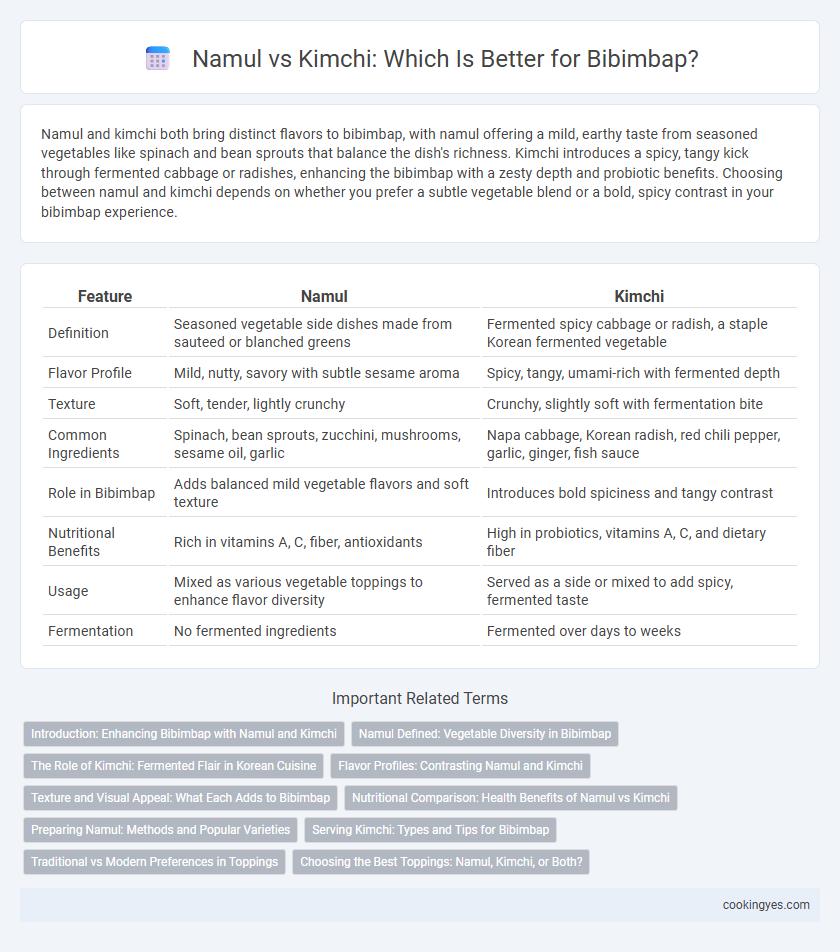Namul and kimchi both bring distinct flavors to bibimbap, with namul offering a mild, earthy taste from seasoned vegetables like spinach and bean sprouts that balance the dish's richness. Kimchi introduces a spicy, tangy kick through fermented cabbage or radishes, enhancing the bibimbap with a zesty depth and probiotic benefits. Choosing between namul and kimchi depends on whether you prefer a subtle vegetable blend or a bold, spicy contrast in your bibimbap experience.
Table of Comparison
| Feature | Namul | Kimchi |
|---|---|---|
| Definition | Seasoned vegetable side dishes made from sauteed or blanched greens | Fermented spicy cabbage or radish, a staple Korean fermented vegetable |
| Flavor Profile | Mild, nutty, savory with subtle sesame aroma | Spicy, tangy, umami-rich with fermented depth |
| Texture | Soft, tender, lightly crunchy | Crunchy, slightly soft with fermentation bite |
| Common Ingredients | Spinach, bean sprouts, zucchini, mushrooms, sesame oil, garlic | Napa cabbage, Korean radish, red chili pepper, garlic, ginger, fish sauce |
| Role in Bibimbap | Adds balanced mild vegetable flavors and soft texture | Introduces bold spiciness and tangy contrast |
| Nutritional Benefits | Rich in vitamins A, C, fiber, antioxidants | High in probiotics, vitamins A, C, and dietary fiber |
| Usage | Mixed as various vegetable toppings to enhance flavor diversity | Served as a side or mixed to add spicy, fermented taste |
| Fermentation | No fermented ingredients | Fermented over days to weeks |
Introduction: Enhancing Bibimbap with Namul and Kimchi
Namul and kimchi both play crucial roles in enhancing the flavors and textures of bibimbap, the iconic Korean mixed rice dish. Namul consists of seasoned and sauteed vegetables that provide a mild, earthy taste, complementing the dish's balance. Kimchi, with its spicy and tangy fermented flavor, adds depth and a refreshing contrast, making both essential for a dynamic bibimbap experience.
Namul Defined: Vegetable Diversity in Bibimbap
Namul, a diverse assortment of seasoned vegetables, represents a core ingredient in bibimbap, highlighting the dish's rich vegetable variety and textures. These lightly sauteed or blanched greens, such as spinach, bean sprouts, and fernbrake, balance flavor and nutrition, contrasting with the spicy, fermented profile of kimchi. Incorporating namul emphasizes bibimbap's focus on fresh, natural vegetable diversity, enhancing both taste and visual appeal.
The Role of Kimchi: Fermented Flair in Korean Cuisine
Kimchi plays a pivotal role in Bibimbap by adding a fermented flair that enhances the dish's complexity and health benefits. Unlike namul, which consists of seasoned sauteed or blanched vegetables providing mild, earthy flavors, kimchi introduces tangy, spicy, and umami-rich notes from its fermentation process. This fermented vegetable element not only balances the flavors but also contributes probiotics that support digestion and overall wellness in Korean cuisine.
Flavor Profiles: Contrasting Namul and Kimchi
Namul offers a mild, earthy flavor with a soft texture that complements the rice and vegetables in bibimbap, providing a subtle balance to the dish. Kimchi delivers a bold, spicy, and tangy punch with its fermented crunch, creating a dynamic contrast to the gentle notes of namul. Combining these elements enhances bibimbap's complexity, blending savory, spicy, and crisp textures for a rich sensory experience.
Texture and Visual Appeal: What Each Adds to Bibimbap
Namul brings a variety of textures to Bibimbap, from the tender spinach to the slightly crunchy fernbrake, enhancing the dish's complexity and providing a fresh, earthy bite. Kimchi contributes a vibrant red color and a bold, spicy tang that contrasts visually and flavorfully with the mild, mixed vegetables, adding depth and excitement to the bowl. The interplay of namul's muted tones and delicate textures with kimchi's fiery hues and crunch creates a balanced and visually appealing Bibimbap experience.
Nutritional Comparison: Health Benefits of Namul vs Kimchi
Namul offers a nutrient-rich blend of seasoned vegetables high in dietary fiber, vitamins A and C, and essential minerals that support digestion and immune health. Kimchi provides probiotic benefits due to its fermentation process, enhancing gut health and supplying antioxidants and vitamins, particularly vitamin K and B-complex. Combining both in bibimbap maximizes nutritional value by delivering a balance of fiber, vitamins, minerals, and beneficial probiotics.
Preparing Namul: Methods and Popular Varieties
Preparing namul for bibimbap involves blanching, sauteing, or seasoning vegetables like spinach, bean sprouts, and fernbrake to enhance their natural flavors and textures. Popular varieties include gosari (fernbrake), sigeumchi (spinach), and kongnamul (soybean sprouts), each providing distinct tastes and nutritional benefits essential for a balanced bibimbap. These seasoned vegetables contrast with kimchi's fermented spiciness, offering a milder, earthy complement that balances the dish.
Serving Kimchi: Types and Tips for Bibimbap
Serving kimchi alongside bibimbap enhances the dish's flavor complexity by adding a spicy, tangy contrast to the savory vegetables and rice. Popular types include baechu kimchi (fermented napa cabbage) and oi sobagi (stuffed cucumber kimchi), both providing unique textures that complement bibimbap's ingredients. For optimal pairing, serve kimchi chilled to maintain its crispness and balance the warm, earthy notes of bibimbap's namul vegetables.
Traditional vs Modern Preferences in Toppings
Namul, a variety of seasoned vegetable side dishes, is essential in traditional Bibimbap, offering a natural, earthy flavor that complements the rice and gochujang sauce. Kimchi, while also a staple in Korean cuisine, represents a modern twist in Bibimbap toppings, adding a spicy, fermented tang that appeals to contemporary tastes. Traditional preferences favor a balance of mild, fresh flavors from Namul, whereas modern variants showcase bold, pungent contrasts with Kimchi as a highlight.
Choosing the Best Toppings: Namul, Kimchi, or Both?
Namul, a variety of seasoned Korean vegetables like spinach, bean sprouts, and fernbrake, offers a mild, earthy flavor that complements bibimbap's rice base while providing nutritional benefits such as fiber and vitamins. Kimchi, fermented spicy cabbage or radish, introduces tangy, umami-rich notes and probiotics, enhancing both taste complexity and digestive health. Combining both namul and kimchi in bibimbap creates a balanced topping medley that delivers diverse textures, flavors, and enhanced nutritional value.
Namul vs Kimchi for Bibimbap Infographic

 cookingyes.com
cookingyes.com